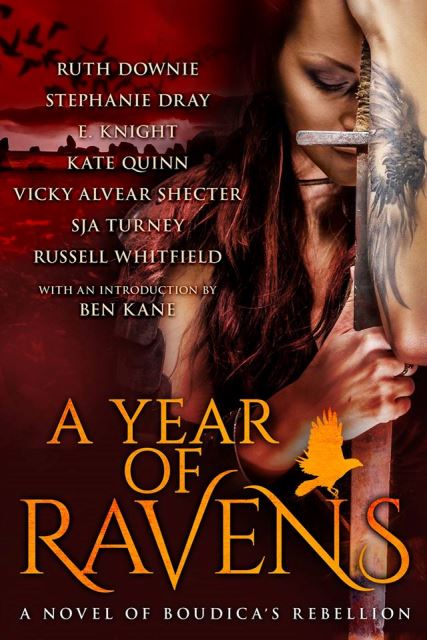Madness and Magic: What Happens when
Seven Authors Tackle One Story
by Vicky Alvear Shecter
Collaborative novels are not new, but they can be difficult to execute. The challenge comes in making each author’s story compelling—with its own arc and resolution—while still moving the novel toward its own satisfying conclusion.
Seven authors took up that challenge with A Year of Ravens: A Novel of Boudica’s Rebellion. Boudica, the woman who took on Rome and nearly won, is one of the most compelling heroes of the ancient world. Four out of Raven’s seven authors—Stephanie Dray, Eliza Knight, Kate Quinn and me—worked on a previous historical fiction collaboration, A Day of Fire: A Novel of Pompeii, released last year. Because of conflicting deadlines, authors Ben Kane and Sophie Perinot were not able to participate. Thankfully, British authors Ruth Downie, Russell Whitfield, and SJA Turney were happy to step in.
The big question, though, was whether this new team could make it work. According to one of the new team members, Russell Whitfield, it was a “nightmare.”
“The others were a bunch of divas and I’m surprised that anything got done with all the preening and posturing,” the author of the Gladiatrix series claims. “It was shocking! Knight refusing to move unless we sent her M&Ms with the red ones taken out… Downie and Turney shouting drunken abuse at each other on Skype… Dray and Shecter threatening me… And that Kate Quinn... Let me tell you… Don’t get on the wrong side of her, man. She’s essentially the Chuck Norris of Historical Fiction. She doesn’t edit. She waits...”
Whitfield, of course, was just kidding.
In actuality, “the collaborative process was a dream,” he points out. “There really are no juicy stories of tantrums and heel-digging or anything like that. The team was utterly professional - it was all about the work and delivering the best story for the reader - as it should be, of course.”
Kate (Chuck Norris) Quinn, author of The Empress of Rome series, concurs. “Working in a collaboration forces your imagination to stretch in new and astounding ways,” she says. “As historical authors, when we choose a piece of history to wrap a story around, we naturally gravitate toward the entire arc of the historical event. But with seven of us, we all had just a piece of the action, not the whole, and that's an entirely new ball-game."
Nothing about the story of Boudica’s rebellion is simple. It encompassed multiple Celtic tribes over multiple generations involving multiple shifting personal and political alliances. And then there was Rome with its coldly-efficient war machine and determination to replenish its wealth on the backs of conquered peoples.
The natural inclination would be to try to simplify the stories and turn them into tales of good versus evil.
But that, according to Stephanie Dray, author of the soon-to-be released America’s First Daughter, the story of Thomas Jefferson’s eldest daughter, Patsy, was exactly what we didn’t want to do.
“We knew we didn’t want to write a simplistic Roman Imperialists Go Home book, which is the obvious choice when tackling Boudica’s story,” she explains. And although the group didn’t discuss “overarching themes in the book” in the beginning, powerful themes developed organically during the process anyway.
“Without planning it, we collectively tackled the broader concept of honor and its impact, good and bad,” Dray says. “All of the stories started spinning around the same themes as if we’d planned them that way because we were feeding off each other’s ideas and thinking about how our own work might say something deeper!”
Often, what started as a simple tale grew complex as it interweaved with the other stories. “I had taken on one of the more straightforward parts of the rebellion to cover - the burning of London and St Albans - and it could have been remarkably easy to do,” says SJA Turney, author of the Marius’ Mules and Praetorian series. “I came up with a concept of a Romanized Briton who would be dashing in and out of the chaos on a personal mission to save someone that would allow a bit of character depth while showing in the background all the horror of the revolt.” But then other authors laid claim to use Turney's Briton in their stories and, as Turney concludes "He gained more depth and color from their influence. And so on . . ."
Ruth Downie, author of the Medicus series, notes that the magic really took off during group discussions. “What took me by surprise was the way the bare bones of Boudica’s story sprang to life when the rest of the H-Team pitched in with the viewpoints of their characters,” she points out. “The fictional people blended so seamlessly with the historical ones that when I visited the British Museum and stood in front of the real weapon that Kate had assigned to her leading man, I almost expected a plaque that said, DURO’S SWORD.”
A Year of Ravens is sometimes quite dark, but then, so was the history itself. From slaves to queens, from warriors to Druids, everyone had a stake in the outcome of the rebellion. The stories in the novel, we hope, capture the heartaches, triumphs, hopes, and dreams of the people from the Land of the Mists and the people who conquered them.
Links:
A Year of Ravens:
Russell Whitfield: http://www.russellwhitfield.com/
Kate Quinn: http://www.katequinnauthor.com/
Stephanie Dray: http://www.stephaniedray.com/
SJA Turney: http://www.sjaturney.co.uk/
Ruth Downie: http://ruthdownie.com/
Vicky Alvear Shecter: www.vickyalvearshecter.com
Eliza Knight: http://www.elizaknight.com/


0 comments:
Post a Comment
Hi! Welcome to A Bookish Affair. If you leave a comment, I will try to either reply here or on your site!
As of 6/6/2011, this book is now an awards free zone. While I appreciate the awards, I would rather stick to reviewing more great books for you than trying to fill the requirements.